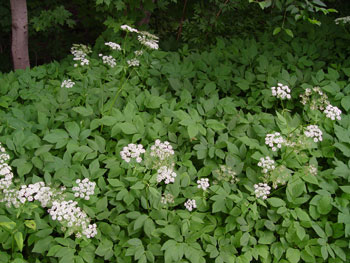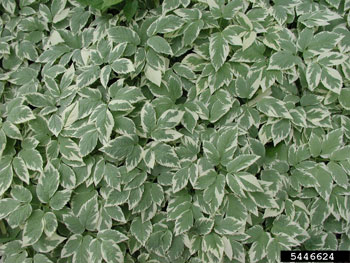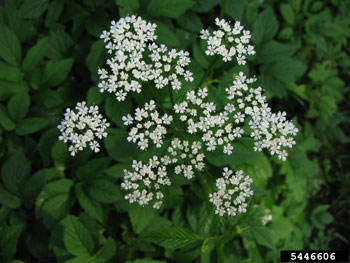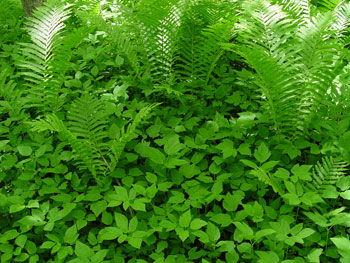DACF Home → Bureaus & Programs → Maine Natural Areas Program → Communities, Plants, and Animals → Invasive Plants → Goutweed
 Goutweed in flower
Goutweed in flower
Goutweed (Bishop's Weed)
Aegopodium podagraria
2019 Status in Maine: Widespread. Severely Invasive.
Description: Herbaceous, perennial ground cover, 1-2' tall, with many common names. Leaves: Compound with variable triternate leaflets; pointed leaflets have serrate margins. Most leaves are basal with long petioles. Wild type is a medium green color while the variegated form is pale bluish breen with white margins. Flowers/Seeds: Typical carrot family flowers; 2-5" diameter umbels of tiny white flowers atop 2-3' stalk. Plants require at least partial sun to flower. Seeds are brown, small and flat. Roots: Fleshy long white white rhizomes, like quackgrass (Elymus repens).
Native range: Europe and Northern Asia. How arrived in U.S.: As an ornamental.
Reproduction: While research shows that goutweed's insect pollinated flowers can produce viable seed, seedlings are rarely encountered. Its branching network of rhizomes allows it to grow aggressively away from plantings or colonize a new site via contaminated soil.
 Variegated leaves of goutweed, Leslie J. Mehrhoff, University of Connecticut, Bugwood.org
Variegated leaves of goutweed, Leslie J. Mehrhoff, University of Connecticut, Bugwood.org
Habitat: Moist soil and light shade are preferred garden spots, but goutweed is content in many habitats. It typically enters forests from runaway plantings or via fill contaminated with rhizome fragments.
Similar native species: Golden alexanders (Zizia aurea) has somewhat similarly shaped leaves but yellow flowers. Anisewood and sweet-cicely (Osmorhiza spp.) also have somewhat similarly shaped leaves but are anice-scented, fruits (seeds) are elongated, and leaves and stems often have hairs. Neither of these species grows with the dense habit of goutweed.
Similar non-native species: Other weedy members of the carrot family.
Documented Ecological Impacts
- Goutweed changes soil chemistry and also raises humidity and reduces light levels near the forest floor which reduces seedling recruitment of shade tolerant tree species such as white pine, black spruce, and balsam fir. Plant species diversity is severely reduced where goutweed grows in natural settings. (Garske, S. 2000. Ecological effects of goutweed (Aegopodium podagraria L.) on a souther boreal forest site. Master's Thesis, University of Minnesota Duluth)
- Goutweed may alter decomposition, nutrient cycling, and other ecological processes in forests and woodlands. (Garske, S. and D. Schimpf. 2005. Goutweed fact sheet, Plant Conservation Alliance)
- Goutweed is pollinated by a variety of beetles, bees, and small flies, and may alter native plant-pollinator interactions. (Waggy, M.A. 2010. Aegopodium podagraria In: Fire Effects Information System, U.S. Department of Agriculture, Forest Service)
- Goutweed has been documented in Maine's floodplain forests. As these wetland forests are rare in Maine, invasions in these areas are of top concern for conservation of biodiversity.
 Goutweed flower, Leslie J. Mehrhoff, University of Connecticut, Bugwood.org
Goutweed flower, Leslie J. Mehrhoff, University of Connecticut, Bugwood.org
Fact Sheets and Identification Links
- Goutweed fact sheet, Plant Conservation Alliance
- Goutweed fact sheet, University of Illinois Extension
- Go Botany Webpage for Goutweed
Control Methods
Hand-pulling will not extract the deeply growing rhizomes, so digging tools are rquired. Dispose of rhizomes in bags in trash to prevent spread*. Repeated excavation will be required. Mowing can slow the spread but is unliekly to exhaust large patches. Poor results are reported for covering with tarps and plastic sheeting. Goutweed is a tenacious ground cover and an excellent candidate for a systemic herbicide application † (triclopyr or glyphosate solution). Apply as a foliar spray during the growing season. Good results have been reported for mowing first and then spraying the leafy regrowth. Multiple treatments may be required.
* Correctly dispose of all plant parts↵ † Follow all label directions when using herbicides↵Control Technique Video Demonstrations
 Goutweed in floodplain setting
Goutweed in floodplain setting
- Ontario Invasive Plant Counsel video on identification, control, and alternatives in ornamental settings (4:35)
- Gardener Ben video on identification and control (3:36)
- Wild Ones Louisville video on ecological impacts and control methods (3:14)
- Maritime Gardiner video demonstrating smothering goutweed (4:31)
Please email invasives.mnap@maine.gov if you have questions about invasive species in Maine